Introducing the Sony EE34
You can't buy it from Sony's website. If you blinked you might have missed the news popping up on a couple of different sites about its existence. If you were on the phone with me when I called Jarred about it, you might even have shared his reaction: "Sony makes a budget AMD laptop?" But sure enough they do, and we have a budget Sony EE34 notebook on hand that's liable to raise more than a few eyebrows. Around $600 for a Sony Vaio AMD-based notebook with a Blu-ray drive standard? They make those?

As a matter of fact, they do. With Intel's Sandy Bridge recall having largely enervated the retail market, we thought it would be a good opportunity to take another look at what AMD has on hand. When we saw the EE34 on the shelf, it wound up being such a curiosity that we knew we had to find out just what exactly a budget Sony Vaio AMD notebook means. This is also the first of hopefully many Sony notebooks we'll be taking a look at in the future and yes, we've heard your calls, we're trying to get a Z series on hand.
In the meantime, though, we're going to check out what happens when an AMD Athlon II mobile processor with a 25W TDP hangs out inside one of Sony's attractive Vaio notebooks.
| Sony EE34 Specifications | |
| Processor | AMD Athlon II P340 (2x2.2GHz, 45nm, 1MB L2, 25W) |
| Chipset | AMD RS880M Northbridge + SB800 Southbridge |
| Memory | 2x2GB DDR3-1333 (Max 2x4GB) |
| Graphics | AMD Mobility Radeon HD 4250 IGP (40 Stream Processors, 510MHz core clock) |
| Display | 15.6" LED Glossy 16:9 1366x768 (LG LGD02CA Panel) |
| Hard Drive(s) | 320GB 5400 RPM (Toshiba) |
| Optical Drive | BD-ROM/DVD+-RW Combo Drive |
| Networking | Realtek PCIe Gigabit Ethernet Atheros AR9285 802.11b/g/n |
| Audio | Realtek ALC269 HD Audio Stereo speakers Headphone and microphone jacks |
| Battery | 4-Cell, 11.1V, 39Wh battery |
| Front Side | MS reader SD/MMC reader Wireless switch Indicator lights Headphone jack Microphone jack |
| Left Side | AC adapter Exhaust vent Ethernet jack D-SUB HDMI USB 2.0 |
| Right Side | 3x USB 2.0 Optical drive Kensington lock |
| Back Side | - |
| Operating System | Windows 7 Home Premium 64-bit |
| Dimensions | 14.56" x 9.78" x 1.26"-1.47" (WxDxH) |
| Weight | 5.90 lbs |
| Extras | Webcam Flash reader (MMC, SD/Mini SD, MS/Duo/Pro/Pro Duo) Blu-ray drive 103 key keyboard with 10-key |
| Warranty | 1-year limited warranty |
| Pricing | Available online for $630 |
It's no big secret that Intel's "Core 2010" series of mobile processors are faster than AMD's current lineup, and that the Sandy Bridge-based "Core 2011" series will be faster still. The problem is that the former are drying up in retail (no doubt due to trying to shift inventory to make room for the Sandy Bridge refreshes) while the latter are still about a month away due to the recall. That leaves us with a healthy amount of AMD-based notebooks on the market, and as we'll see that's not such a bad thing.
The Athlon II P340 (so nice of AMD to finally do away with any sense of logic in their chip naming just like Intel did) is basically the same as the dual-core desktop Athlon II, with no L3 cache but 512KB of L2 cache per core. It runs at an unexciting 2.2GHz, but should still provide enough processing power to handle most tasks. The best part, of course, is that this chip also features a 25W TDP that you'll see Sony actually manages to get some mileage out of.
Well, that's not the only best part. The other part is that while AMD's 40-shader integrated graphics haven't exactly aged gracefully, they're still better than any other IGP currently widely available on the market (NVIDIA's GeForce 320M is only available in MacBooks, and the 9400M is basically gone now) barring the Radeon HD 6310 in AMD's E-350, which brings with it the baggage of a much slower processor. As a result the Mobility Radeon HD 4250 may not be much but it can at least get the job done for the lightest of gaming, though most users will be disappointed to see it doesn't share the 700MHz core clock of the desktop IGP.
The other big selling point of the Sony EE34 is the Blu-ray drive, making it a very affordable way to get a decent computer and a Blu-ray player in one shot. The middling 720p screen may not help you get the most out of your movie watching experience, but it's a start, and there's always the HDMI port for external displays.
As for the rest of the EE34, connectivity is generally good and the 4GB of DDR3 is ample, but the system is bogged down by a lowest-common-denominator 5400RPM Toshiba hard drive with a paltry 8MB of cache. Every time I have to use a Toshiba or Fujitsu hard drive I feel like I'm being punished for something, and it's a disappointment to see them when most vendors have switched to using Seagate or Western Digital drives (though Samsung and Hitachi are also fine candidates.)
An Inexpensive Vaio?
Notice in the headline I didn't use the word "cheap," and there's a reason for that. While there's a decent amount of glossy and matte black plastic and the overall build quality does feel a little more chintzy than some of Sony's more upscale models, as a whole the EE34 doesn't actually feel like a cheap machine.
Writing about the Sony Vaio EE34's looks is going to result in a fairly short review, and that's due largely to the prevalence of black matte plastic all over the build. Sony wisely eschews using glossy plastic on the lid, and though I've found it can still pick up dust it isn't a grease and fingerprint magnet. It thankfully seems like the era of glossy plastic really is finally drawing to a close.
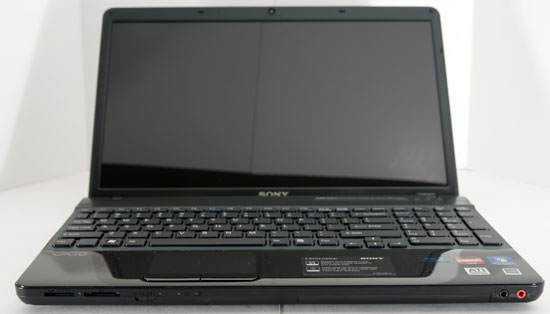
The hinge of the lid allows the screen to tilt back about 135 degrees, allowing for a decent range for finding that sweet spot viewing angle, and the screen bezel itself is thankfully also a matte plastic. At this point only a couple of manufacturers seem to be persisting in putting that gloss where it doesn't belong; most of the others have moved on.
That matte plastic follows down to the inside panelling of the Vaio, through the speaker grille above the chiclet-style keyboard and stopping at the palm rest. Sony has opted to employ glossy plastic for the palm rest, integrated touchpad, and mouse buttons, but at least it kind of makes sense here. Because the gloss is a deep black it doesn't show fingerprints quite as badly as it could, and it's actually fairly attractive. This is probably how glossy plastics should have been used to begin with.
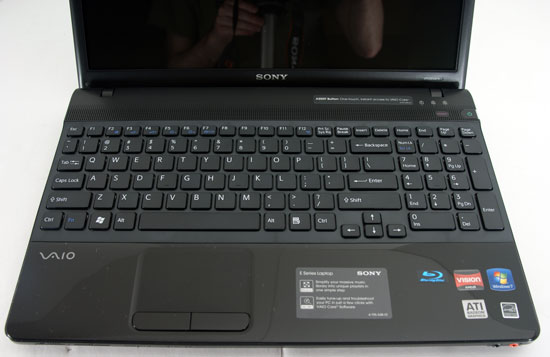
If you're a fan of chiclet-style keyboards you're liable to be at home with the Vaio EE34's. The keyboard has a smart layout that makes full use of the width of the notebook while having minimal flex, and the 10-key is comfortable to use with document navigation keys wisely placed above it. About the only complaint one could reasonably make about Sony's keyboard is that the keys themselves feel a bit on the small side, but most users should be able to get used to them without too much trouble.
The touchpad is textured and is fine for general use, but it's still another perpetrator of one of those cheapest of crimes: being a part of the inside panel instead of being apart from the inside panel. This is something that has very seldom looked good, and while Sony almost pulls it off with the EE34 it still feels like a cut corner. Given the budget nature of this notebook that's something that we can overlook, and the touchpad (and accompanying mouse buttons) has a good enough feel to it that you're not going to be cursing their engineers every time you have to use it.
Upgrading the Vaio EE34 is thankfully not too arduous a task, although a series of little details on the bottom just scream Sony eccentricity. The battery hinges into the notebook in a way that's going to seem unusual; you'd expect it to just slide into the back the way most laptop batteries do, but this one actually has to be inserted at an angle, then canted in and snapped into place. And while the hatch for upgrading the RAM is easy enough to access (single screw, panel pops off), the hard drive bay winds up being sillier than it looks. After unscrewing that panel, you actually have to slide it off instead of just lifting it up. None of these are major problems and they're really only worth mentioning because they're fitfully amusing. If you're used to removing these things in a lot of other notebooks you'll pause for a second and go "wait, what?"
As a whole the EE34 doesn't feel particularly chintzy and at least looks better than a lot of other budget notebooks in its price range. Some users aren't big fans of Sony's designs, but I've always found Vaios to be attractive, stylish notebooks and this one is no different.
Not Fast, But Fast Enough
Historically we've been pretty underwhelmed with AMD's mobile offerings, barring maybe the Turion II Neo and now Brazos. These aren't bad chips, but if AMD's been struggling to play catch-up on the desktop they've been left miles behind in notebooks where power and heat become ever more important.
With that said, though, the 25W, 2.2GHz Athlon II P340 dual-core processor isn't a particularly bad chip either. Inheriting the K10.5 architecture from its desktop siblings, it at least offers a good bump over older K8-based chips and is capable of handling most of the tasks you're liable to throw at it.
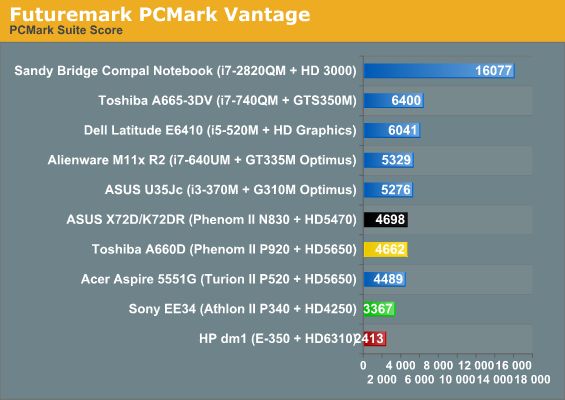
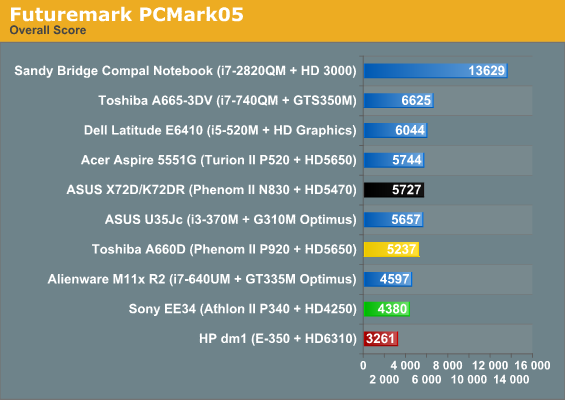

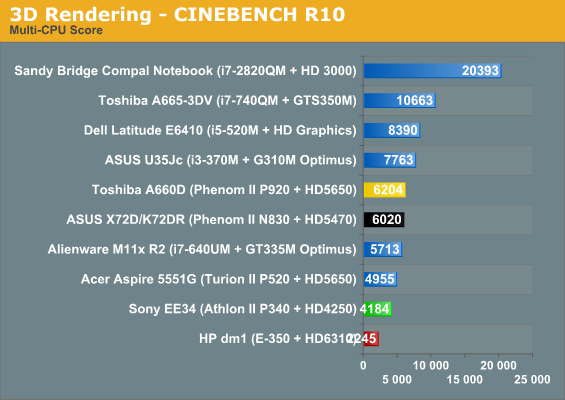
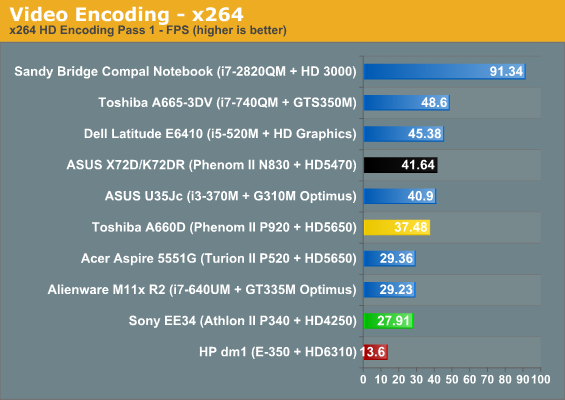
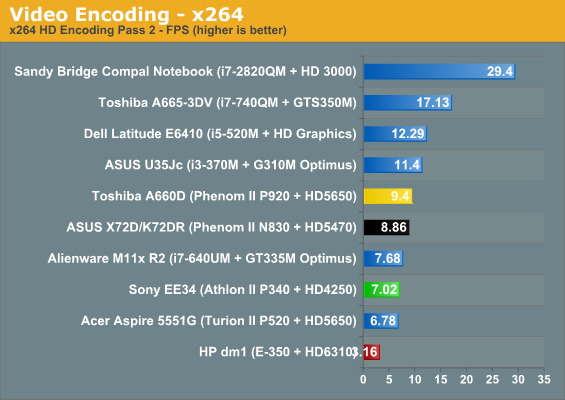
Before we get too far in analyzing these results, it's important to note that our usual x264 benchmark refused to run on the EE34 and would always crash at exactly the same point. This occurred whether on the factory install or on a clean installation of Windows 7, and it's the only time we've ever seen this happen. The EE34 completed all our other tests perfectly fine and was nice and stable in regular use, but it bears mentioning that for the x264 results we did have to simulate the processor using a desktop Athlon II X4 with two cores disabled and the clocks adjusted. I'm confident that these scores are within the ballpark for what you could expect from the Athlon II P340, but they bear mentioning nonetheless.
Comparing against the other AMD processors in the lineup, the P920 is a quad-core chip running at 1.6GHz while the N830 is a tri-core chip running at 2.1GHz. So with that in mind, the tri-core running at 100MHz slower than the P340 in the EE34 seems like it's probably the best compromise, but the P340 doesn't put in an awful showing either. All of the AMD chips are more or less dwarfed by their Intel rivals, but it's not a complete bloodbath. For reference we've included the E-350's scores so you can see what bumping up to even a slower full-sized AMD notebook can get you.
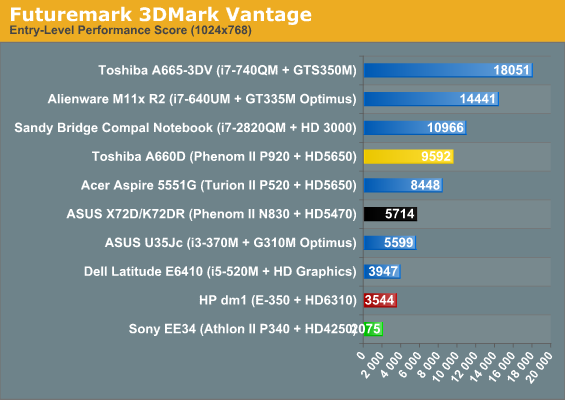
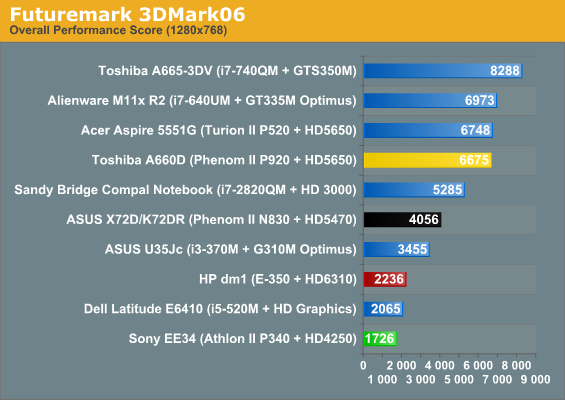
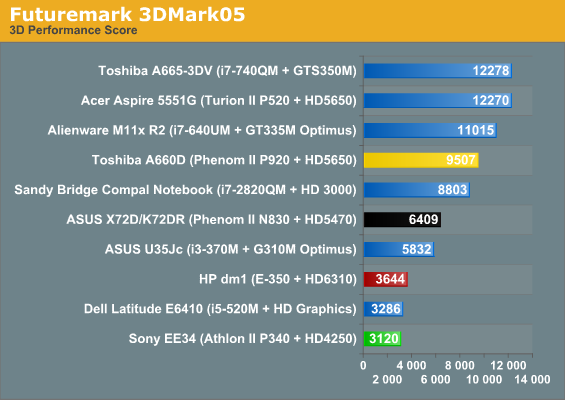

Unfortunately the 3DMark tests bear out just how poorly AMD's 40-shader IGP has aged. The E-350 beats it at every turn and even the utterly anemic GeForce 310M is a substantial improvement. While Llano's CPU performance doesn't promise to be a substantial improvement over what we've seen here (the cores are basically K10.5), the integrated graphics should at least be a big enough boost to make it a very compelling mobile part. Hopefully between Brazos, Llano, and Sandy Bridge, the era of poor integrated graphics can finally come to a close.
Middling Gaming Even at 720p
The 720p resolution should really be the low-ball target for graphics hardware at this point, but virtually no integrated parts are really there yet. While Intel's HD graphics largely had their way with the Sony EE34's Mobility Radeon HD 4250 in Futuremark, actual gameplay promises to be an improvement.






The situation is pretty dire when even the GeForce 310M is running wild. That said, while Intel's HD graphics certainly look to fare reasonably well against the HD 4250 it's important to keep in mind that AMD's graphics hardware has vastly superior drivers and much better compatibility. The HD 4250 is probably fine for gaming at 800x600 in a pinch and at least the CPU can handle the load (unlike the E-350), but really no integrated part except maybe the delayed Sandy Bridge hardware can promise a good gaming experience on recent titles. Set the way-back gaming machine for 2005 or so and you'll be a lot happier.
Unfortunately, updating the HD 4250's drivers is going to be an exercise in futility. Much like Toshiba inexplicably chose to, Sony has also opted out of AMD's mobile graphics driver program. That leaves you stuck trying to update the video drivers for a laptop Sony seems terrified of even acknowledging on its website. If you happen to have another notebook with AMD mobile graphics in it, you can use that to download the driver package and it'll install fine on the EE34, but that seems like a silly step to even have to take.
Battery Life
When we get to the battery running time we also hit probably the most pleasant surprise about the Sony EE34. We're used to seeing pretty dismal battery life out of most AMD portables, and with the remarkably small battery the EE34 is equipped with (39Wh? Seriously?) the prognosis really only gets worse. So surprise surprise, the EE34 actually doesn't do half bad.
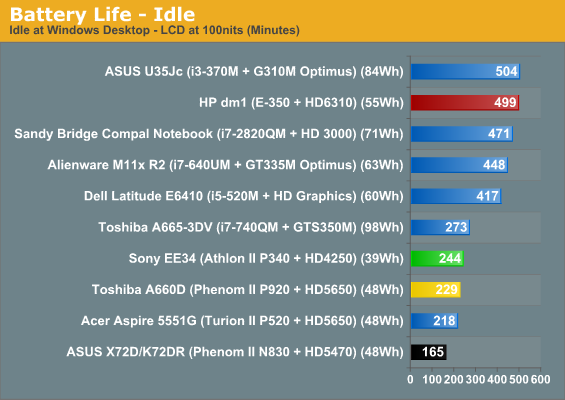
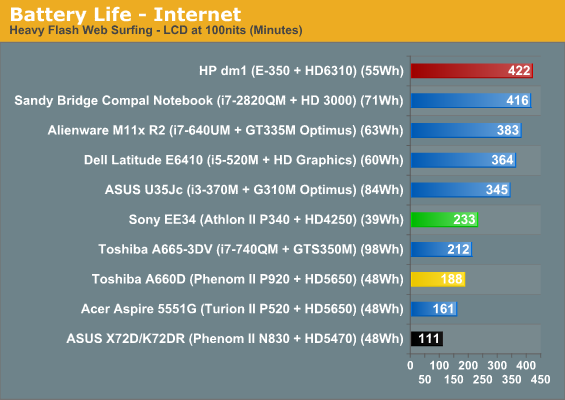
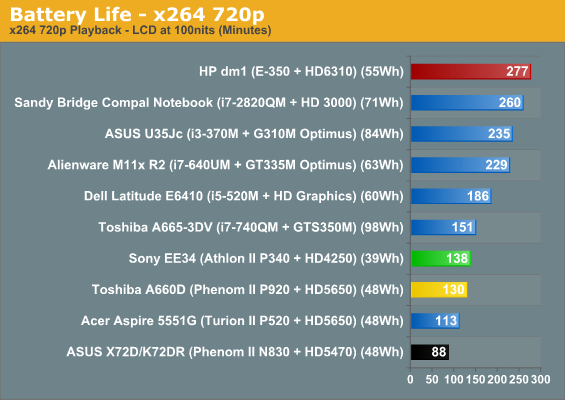
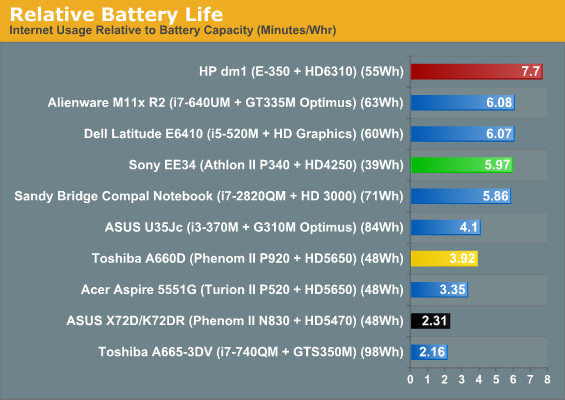
Would you look at that: the 25W Athlon II P340 is actually able to pull nearly four hours of running time while surfing the internet! Not too shabby and a long way from the dismal numbers the other AMD-based notebooks (barring the nimble HP dm1z) pull. It's still not quite enough to bring it up to the running times of the Intel machines, but if you look at the relative battery life you'll see the EE34 doing a pretty stellar job with what it has given that it ships with a battery so small a netbook would be embarassed to be caught with it.
Heat and Noise
Given the integrated graphics and reasonably low wattage processor Sony ships the EE34 with, it should come as no surprise that the notebook actually runs fairly cool and quiet.

These temperatures are actually really good. We're used to seeing AMD mobile chips run hot, but the 61C on the cores is actually frosty even by Intel mobile standards. There may not be much to cool, but what there is, the EE34 seems to do a good job of cooling it.
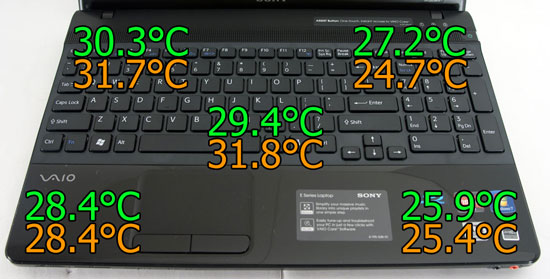
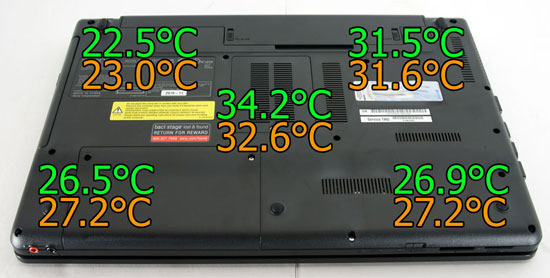
The surface temperatures of the EE34 are all pretty reasonable, with the hottest point typically being the space above the memory access panel. The cooling system actually seems to be remarkably efficient; when placed under load the fan remains very quiet but pulls a lot more heat away, resulting in parts of the notebook actually running cooler under load than idle. It's strange, but overall the EE34 remains comfortable to use and nicely inobtrusive.
Another Bad 720p Screen
Given the budget nature of the Sony EE34 it's probably not unreasonable to expect a poor quality screen, but the one on this notebook seems uncharacteristically bad. My current whipping boy for bad screens is Gateway's ID49C, and as luck would have it the EE34 exhibits some very similar characteristics to that one. Dithering and latticing seem remarkably just as pronounced, and there even seem to be some minor issues with ghosting. None of these are dealbreakers, but know what you're getting into: unless you're really on a tight budget you're not going to want the EE34's screen to be your primary.
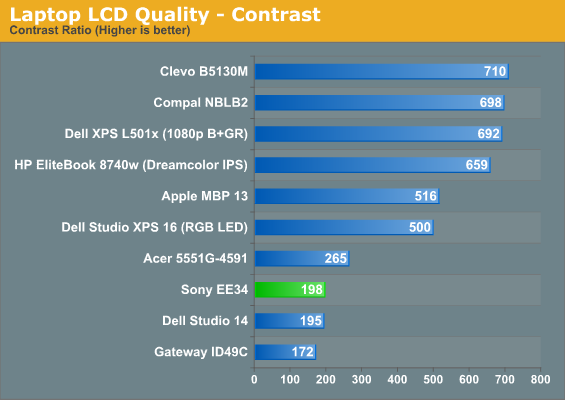
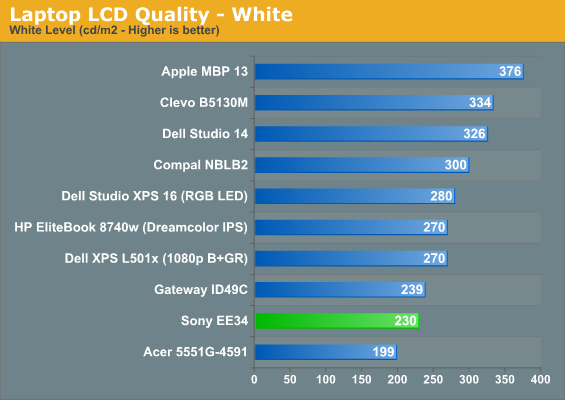
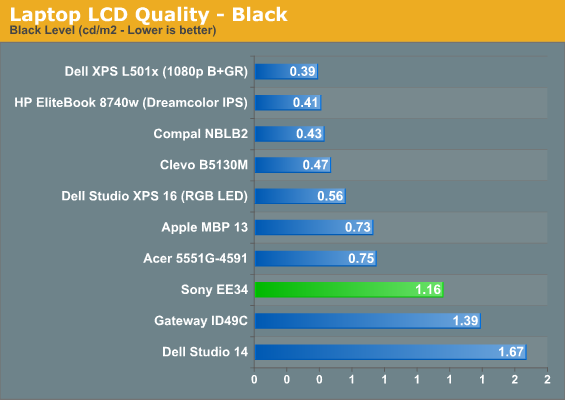
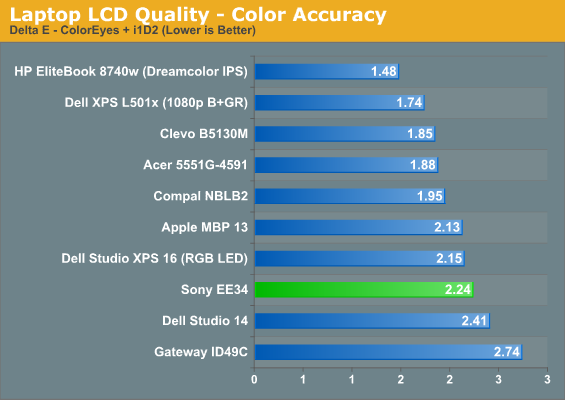
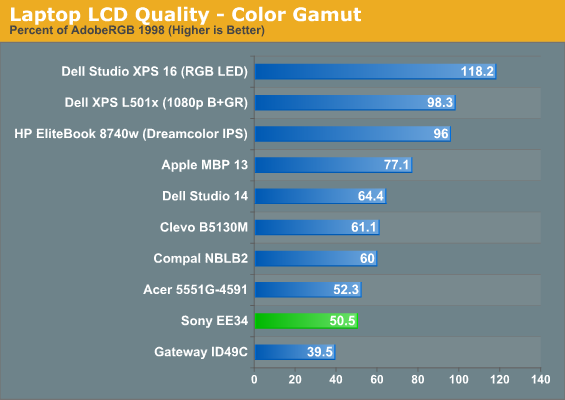
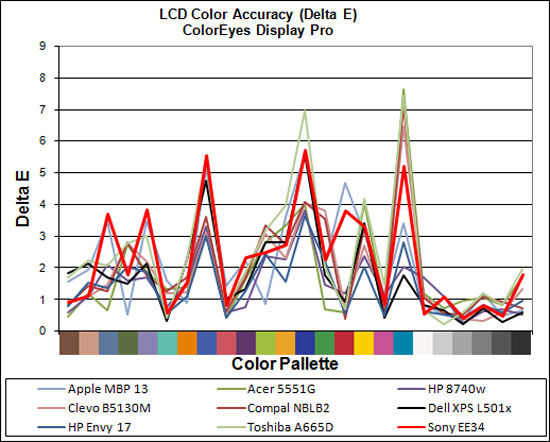
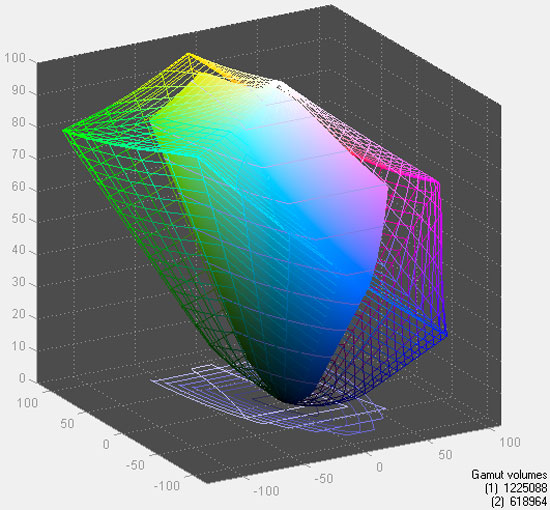
Part of the major problem with these 14" and 15" 1366x768 screens is that they just seem idiotically low-resolution. I was testing the EE34 next to the HP dm1z, and while they produce fairly similar (read: bad) numbers, the dm1z was much more pleasing to look at simply due to the smaller screen producing a finer picture. More and more 1366x768 seems just too small for a screen this size, and what becomes ever more frustrating is that while desktop screen resolutions really have improved somewhat (compare how small 1080p screens get against how small the 1920x1200 screens did), notebook screen resolutions and accompanying quality seem to get worse year over year. Did we really regress so far back that we're going to accept 768 pixels of vertical space again?
But that's not entirely fair to the EE34. Given that with a coupon on NewEgg this notebook can be had for under $600 the complaint becomes more of a general one than specific to the model. Viewing angles aren't completely terrible on the EE34 either, though you'll still spend some time futzing with trying to find the sweet spot (an issue a finer resolution seems to actually improve a bit).

